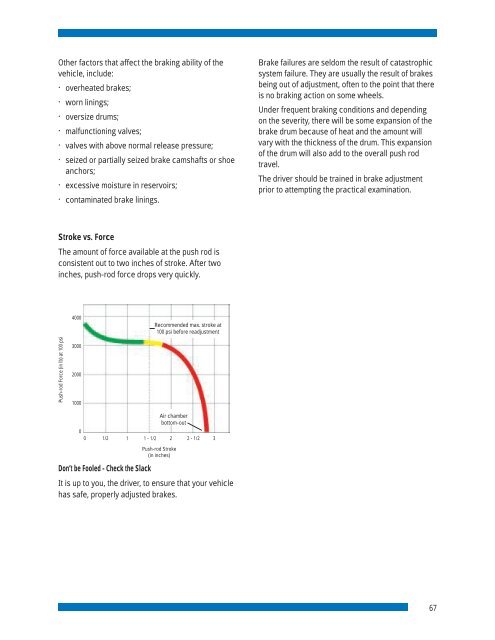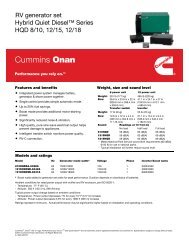Air Brake Manual
Air Brake Manual
Air Brake Manual
Create successful ePaper yourself
Turn your PDF publications into a flip-book with our unique Google optimized e-Paper software.
Other factors that affect the braking ability of the<br />
vehicle, include:<br />
· overheated brakes;<br />
· worn linings;<br />
· oversize drums;<br />
· malfunctioning valves;<br />
· valves with above normal release pressure;<br />
· seized or partially seized brake camshafts or shoe<br />
anchors;<br />
· excessive moisture in reservoirs;<br />
· contaminated brake linings.<br />
<strong>Brake</strong> failures are seldom the result of catastrophic<br />
system failure. They are usually the result of brakes<br />
being out of adjustment, often to the point that there<br />
is no braking action on some wheels.<br />
Under frequent braking conditions and depending<br />
on the severity, there will be some expansion of the<br />
brake drum because of heat and the amount will<br />
vary with the thickness of the drum. This expansion<br />
of the drum will also add to the overall push rod<br />
travel.<br />
The driver should be trained in brake adjustment<br />
prior to attempting the practical examination.<br />
Stroke vs. Force<br />
The amount of force available at the push rod is<br />
consistent out to two inches of stroke. After two<br />
inches, push-rod force drops very quickly.<br />
4000<br />
Recommended max. stroke at<br />
100 psi before readjustment<br />
Push-rod Force (in lb) at 100 psi<br />
3000<br />
2000<br />
1000<br />
0<br />
<strong>Air</strong> chamber<br />
bottom-out<br />
0 1/2 1 1 - 1/2 2 2 - 1/2 3<br />
Don’t be Fooled - Check the Slack<br />
Push-rod Stroke<br />
(in inches)<br />
It is up to you, the driver, to ensure that your vehicle<br />
has safe, properly adjusted brakes.<br />
67




